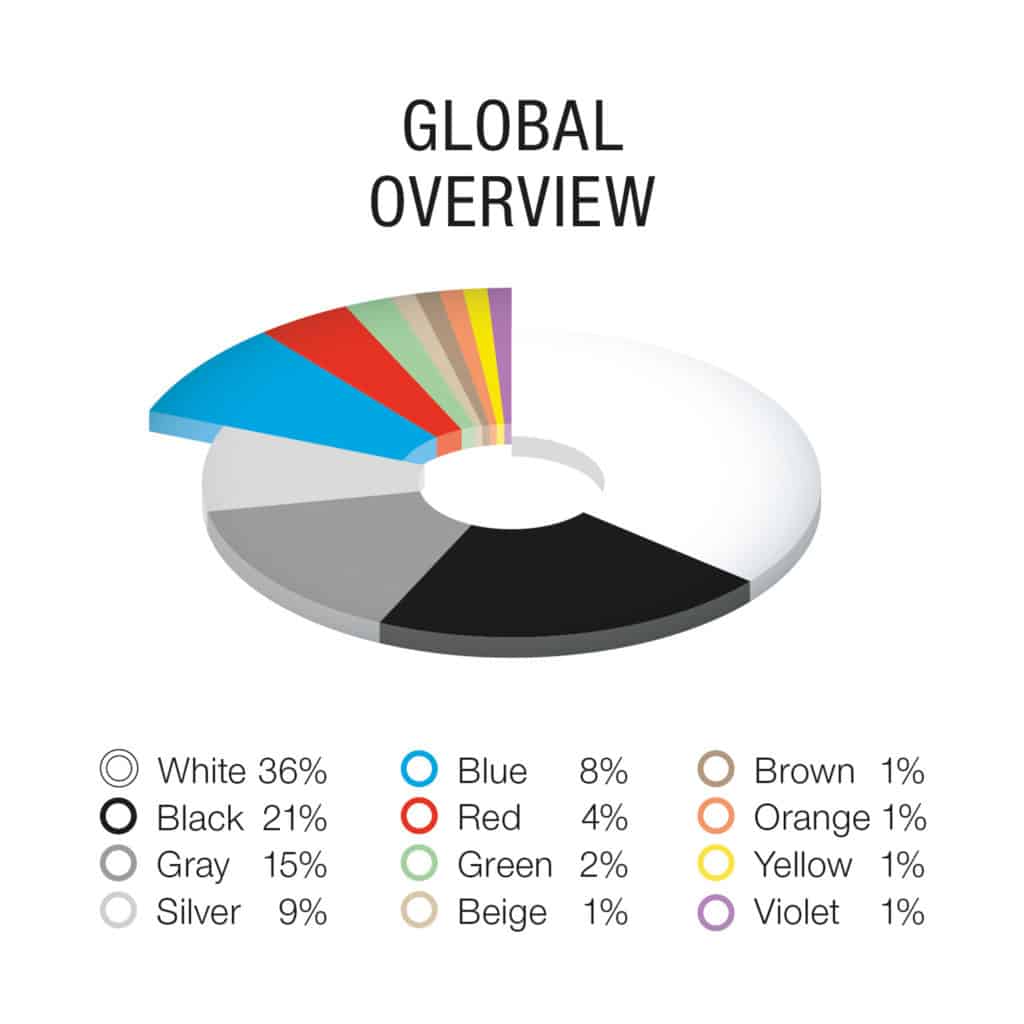White remains king, but black gains in popularity
In trend research released last Autumn, BASF stated that the traditional automotive colour wheel was going through a transformation. The recently released 2023 BASF Colour Report for Automotive OEM Coatings provides hard data to back up that trend.
Achromatic colours, which have always formed the foundation of automotive color, are experiencing a significant shift. While white continues to hold its position as the most popular colour for light passenger vehicles, it has seen a notable decrease in market share. In contrast, black has surged in popularity, gaining market share at the expense of white.
Consumer preferences also vary across different regions. For example, in North America, there is a growing preference for lighter shades of silver over darker grays, while in EMEA, the trend leans towards darker shades. This regional variation adds an intriguing dimension to the evolving colour landscape.
Meanwhile, chromatic colours have remained stable, with no significant changes in their total market share (19%). This category includes a range of colours such as blue, red, brown, and beige, which continue to maintain their popularity among customers.

EMEA: Diverse colour tastes across nations; achromatic shades reign while chromatic favourites differ
The achromatic colours – white, black, gray, and silver – gained two percentage points in Europe, the Middle East, and Africa (EMEA). Car buyers shifted away from lighter colours of white and silver, to darker shades of black and gray. Premium cars had more effects pigments than entry and mid-price classes, showing the depth and creativity of colour.
When European consumers chose colours, there were country-specific preferences. Germany loves blue (11%), Spain and the UK prefer red and orange (approximately 9%), France adores green (6%), and Italy shows its love for all the colors, with its share of chromatic colours being the largest among all five countries (30%).
“While the achromatic colours are still the most popular, each country appears to have its favourite place on the chromatic realm,” said Mark Gutjahr, global head of automotive colour design for BASF. “Different colour distribution could be seen in each of the major EMEA countries, and in general. Our customers, the automakers, have left a lot of room for individuality and creativity in car dealerships now, and car buyers are taking advantage of that.”
North America: Lighter achromatic colours and more effects pigments show up
Like EMEA, achromatic colours in North America – white, black, silver, and gray – gained two percentage points overall. Consumers moved in a lighter direction after automakers retired several gray colours. Those were often replaced with shades of silver.
North America also had the highest share of red cars compared to other regions in 2023. However, red was not able to beat blue as the most popular chromatic colour in North America.
“We’re experiencing the same shift that other regions are seeing,” said Elizabeth M. Hoffmann, colour designer for North America. “The old standard colour palette no longer applies. Lighter shades are getting more popular, taking market share from gray. More and more choices have effects pigments to give them intensity and excitement.”
Asia Pacific: Increasing chromatic colours with more variations in effects
Continuing its leading position in the new automotive colour palette, the share of chromatic colours in Asia Pacific was slightly up compared to 2022. The popularity of natural colors increased, especially green. Lighter colours became more popular, especially light grayish colors and silver.
Part of the reason Asia Pacific is more diverse in colour is for the great variation of body types. Fresh shades can be seen in New Energy Vehicles (NEVs) especially more green and purple-influenced colours.
“As various new vehicles hit the roads, it is only natural that a more vibrant colour palette would follow,” said Chiharu Matsuhara, head of automotive colour design for Asia Pacific. “With new automakers creating new vehicles in Asia, they are asking for something more than the usual colour wheel. They want something bold and creative on their new designs, and young consumers appreciate those colours.”
South America: Continues to be the region with the largest share of achromatic colours
South America historically has a conservative approach to colours, with a huge portion of achromatic colours in 2023. A total of 86% of new vehicles assembled in South America had either white, black, silver, or gray bodies, the most among all regions. The proportion of silver is also highest in South America.
With that kind of market, more and more automakers are choosing effects pigments to make the achromatic colours stand out. More cars were delivered with effects pigments in all body sizes compared to 2022.
“Colours aren’t just colours any more. They are experiences,” said Marcos Fernandes, director, BASF Coatings South America. “Whether it’s a pearl or metal flake or other pigment, the effects make the colour leap from the vehicle into the eyes of the beholder. It gives a certain flair that’s becoming more and more popular.”
The BASF Colour Report for Automotive OEM Coatings is a data analysis from BASF’s Coatings division based on global automotive production and paint application to non-commercial vehicles in 2023.

